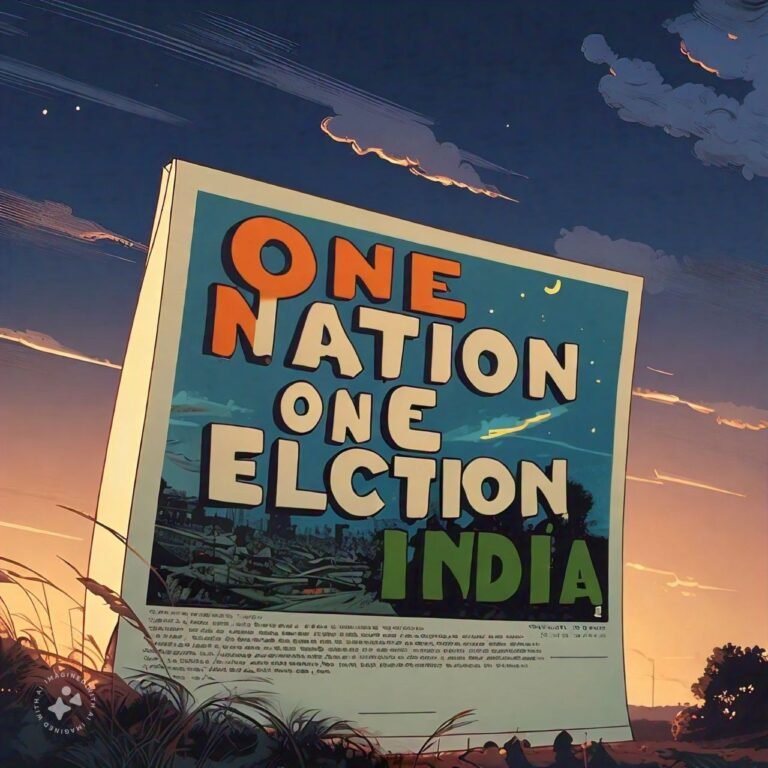
Introduction to One Nation One Election
The concept of ‘One Nation, One Election’ revolves around the proposal to conduct simultaneous elections for the Lok Sabha and State Legislative Assemblies in India. The idea aims to consolidate the electoral process, reducing the frequency of elections and thereby facilitating a more efficient governance model. This proposal has been a subject of extensive debate and discussion within political circles, reflecting a desire to streamline the electoral framework in the country.
Historically, the idea of simultaneous elections is not new. The issue was first brought to light in the early years after India’s independence, with some policymakers suggesting that holding elections at the same time could lead to better resource management and reduced administrative burdens. Over the decades, various commissions and committees have examined this proposition, evaluating its potential benefits and accompanying challenges. Notably, the Law Commission of India expressed support for the concept, emphasizing that it could enhance the efficiency of governance and reduce the costs associated with repeated electoral processes.
One of the fundamental arguments in favor of ‘One Nation, One Election’ is the potential it holds for creating a more stable political environment. By synchronizing elections, the aim is to diminish the chances of political fragmentation that often arise when elections are held frequently across different states. Additionally, proponents argue that simultaneous polls could enable voters to focus on larger national issues rather than being distracted by the localized narratives that tend to dominate state elections.
This approach seeks not only to improve the efficiency of the electoral process but also to limit the disruption that regular elections can cause in the functioning of government. As India continues to grow as a democratic nation, the need for an effective electoral system becomes increasingly important. Therefore, understanding the intricacies of ‘One Nation, One Election’ is crucial for evaluating its overall impact on Indian democracy.
The Rationale Behind One Nation One Election
The initiative for One Nation, One Election stems from a compelling need to reform the electoral process in the country. One of the primary motivations behind this proposal is the significant reduction in election-related expenditures. Conducting simultaneous elections is believed to curtail the financial resources spent on organizing and administering multiple electoral exercises, which often burden state and central governments with inflated costs. By consolidating elections, both the administrative expenses and the financial impact on the polity can be significantly mitigated.
Moreover, frequent elections can seriously disrupt governance and development processes. Governments require stability and continuity to implement policies effectively, and multiple elections can lead to political instability, bureaucratic delays, and a lack of long-term planning. By adopting the One Nation, One Election system, the government aims to establish a stable environment that minimizes interruptions to the legislative process, thereby enhancing the efficacy of governance. This predictability can foster a more conducive atmosphere for both policy formulation and implementation.
Supporters of this initiative, including several politicians and policymakers, argue that it also has the potential to improve voter engagement and participation. When elections occur less frequently, there may be a heightened sense of importance associated with the electoral process, encouraging citizens to be more informed and actively involved in democratic practices. The initiative could streamline the electoral cycle, fostering a deeper political dialogue and allowing for the establishment of a more focused political agenda.
While the arguments in favor of One Nation, One Election are compelling, it is essential to consider the broader implications and challenges that may arise from its implementation. However, the motivations focused on improving governance, reducing expenditures, and encouraging voter participation remain salient throughout discussions surrounding this important electoral reform.
Benefits of One Nation, One Election
The implementation of the One Nation, One Election initiative brings forth a series of significant advantages for governance and democratic processes. Among the most evident benefits is the potential for substantial cost savings. Conducting simultaneous elections would enable the government to reduce the overall expenditure associated with separate elections, including costs related to security, personnel, and logistics. This financial efficiency can subsequently redirect funds towards essential development projects and public welfare initiatives, fostering economic growth.
Moreover, One Nation, One Election promises to alleviate the logistical burdens on the Election Commission. Managing elections can be both challenging and resource-intensive, requiring meticulous planning and execution. By consolidating elections, there is an opportunity to streamline operations, minimize deployment costs, and optimize the utilization of human resources. This would not only enhance the efficacy of the electoral process but also enable the Election Commission to focus on its core mandate without the pressure of managing multiple election cycles within short timeframes.
Additionally, establishing a synchronized election system could contribute to a more stable political environment. When elections are held simultaneously, it reduces the frequency of electoral cycles which can sometimes create an atmosphere of political instability. A stable election schedule may encourage governments to focus on governance rather than constantly preparing for elections, leading to more consistent policy implementation. Furthermore, the initiative holds the promise of enhanced voter engagement and awareness. Holding elections simultaneously can ignite increased public interest in the political process, as voters may be more inclined to participate when elections are consolidated. This potentially leads to higher voter turnout and a more informed electorate, strengthening the foundations of democracy.
Challenges and Concerns
The concept of One Nation, One Election aims to synchronize state and national elections across India, purportedly to enhance electoral efficiency and reduce costs. However, this idea is not without significant challenges and concerns that merit thorough examination. One of the foremost criticisms centers around the constitutional implications of such a reform. India’s Constitution delineates the terms and schedules governing elections at both the state and national levels. Altering this framework to enable simultaneous elections could necessitate substantial amendments, raising questions about the legality and practicability of such changes.
Another concern is the potential marginalization of regional parties. The political landscape in India is rich and diverse, with numerous regional parties representing localized interests. Critics argue that synchronizing elections may favor larger, national parties, as they tend to have more resources and widespread recognition. This could lead to diminished representation for regional parties, ultimately undermining the federal structure of governance that allows states to assert their unique political narratives.
Practical challenges also abound when considering the logistics of conducting simultaneous elections. Coordinating various election schedules requires meticulous planning, not only in terms of administrative capacity but also regarding voter education and awareness. The risk of voter fatigue due to simultaneous campaigning could lead to decreased voter turnout and engagement. Furthermore, the opposition parties and civil society groups raise alarms over potential electoral malpractices that may arise from this concentrated electoral approach. Concerns about the integrity of the electoral process are exacerbated by the likelihood of political polarization, which could compromise the fairness of elections.
In conclusion, the idea of One Nation, One Election presents a range of formidable challenges and concerns that warrant careful consideration. These potential drawbacks must be thoroughly assessed to ensure that the democratic ideals of representation and fairness are maintained.
Constitutional Amendments Required
Implementing the “One Nation, One Election” initiative in India necessitates significant legal and constitutional modifications. The current electoral framework is governed by multiple provisions within the Indian Constitution, which would require reevaluation and potential amendment to facilitate simultaneous elections. Key articles that may need revision include Article 83, which stipulates the duration of the Houses of Parliament, Article 172 concerning the duration of state legislatures, and Article 356, which outlines the imposition of President’s Rule in states.
Article 83 specifies that Lok Sabha and Rajya Sabha members are elected for a five-year term, unless dissolved earlier, while Article 172 lays out similar guidelines for state legislative assemblies. A synchronization of the election cycles would imply that either parliamentary or state assembly terms might need to be adjusted. Additionally, provisions regarding the dissolution of assemblies must be aligned to prevent staggered elections, thus enabling the proposed unified electoral process.
The legislative process to amend the Constitution involves a series of formal steps. Initially, a proposal must be drafted and presented to either house of Parliament. For bills amending the Constitution, a simple majority is insufficient; a two-thirds majority is required in both the Lok Sabha and Rajya Sabha. Following this, the amendments must be ratified by at least half of the state legislatures if they pertain to matters such as the duration of state legislatures, as per Article 368.
Furthermore, public discourse and debate may accompany this initiative, challenging the enforceability of such amendments and concerns regarding federalism. As such, thorough discussions must take place to ensure that any proposed constitutional amendments not only comply with existing legal frameworks but also address the apprehensions of various political factions and stakeholders.
Case Studies and Global Examples
Simultaneous elections, although a relatively new concept in some parts of the world, have been successfully implemented in various countries, offering valuable insights into the potential benefits and challenges associated with the One Nation, One Election initiative in India. One prominent example can be found in Australia, where federal and state elections often coincide. This practice has shown efficiency in reducing the costs associated with conducting multiple elections individually, as well as in increasing voter turnout, given that citizens are able to cast their votes in a single event.
Another noteworthy case is France, which holds its parliamentary elections shortly after the presidential election. This strategic scheduling allows for coherence in governance as elected representatives share a mandate, thereby creating a more stable political environment. The French model demonstrates the advantage of synchronizing electoral processes, ensuring that policies and government agendas can be consistently pursued without interruption from staggered elections.
Moreover, Sweden adopts a unique approach where municipal elections are held simultaneously with national elections. This has resulted in enhanced voter engagement and clarity regarding the political stakes at play, as constituents are compelled to consider both local and national issues simultaneously. The Swedish model can provide key insights for India, particularly in promoting citizen participation and informed voting.
Lastly, Nigeria has faced challenges with its experience of simultaneous elections, particularly during conflict situations. These challenges highlight the importance of careful planning and addressing regional disparities to ensure fairness and security in the electoral process. Lessons from Nigeria reinforce the necessity for robust infrastructural and institutional support to tackle potential hurdles in executing simultaneous elections.
In summary, examining these global examples allows stakeholders in India to identify best practices and potential pitfalls associated with the One Nation, One Election concept, contributing to a more informed approach towards implementing this initiative. Each case presents distinct adaptations and outcomes that can enhance the understanding of simultaneous elections in diverse contexts.
Public Opinion and Political Feasibility
The concept of One Nation, One Election has garnered a wide range of public opinions, driven by various surveys that indicate differing levels of support among the electorate. Many citizens acknowledge the potential advantages of synchronizing elections, such as reducing election-related expenditures and enhancing governance efficiency. According to a recent survey conducted by a leading research organization, approximately 63% of respondents expressed support for the initiative, citing the belief that it could foster greater political stability and reduce the costs associated with frequent election cycles.
However, the support for One Nation, One Election is not uniform across all demographics. Political analysts observe variance in sentiment along regional lines, with some states showing stronger opposition due to apprehensions about local issues being overshadowed by national agendas. Additionally, several expert opinions suggest that political feasibility may face significant hurdles, particularly from regional parties that fear a loss of representation and influence in the political landscape. These parties often argue that local governance issues could be neglected if elections are held concurrently at both state and national levels.
The political landscape further complicates this issue. Major political parties have voiced differing stances on the proposal, which contributes to its perceived complexity within the electorate. While some national parties have shown optimism toward One Nation, One Election, viewing it as a means to consolidate power and reduce campaign expenditures, others remain critical, emphasizing the need to prioritize local governance. This divergence of opinion illustrates the multifaceted nature of public sentiment regarding the proposal.
In summary, while there is tangible support for One Nation, One Election among segments of the public, concerns about political representation, local issues, and varying party attitudes could pose significant challenges to its implementation. As public sentiment evolves, the feasibility of this electoral reform remains a critical discussion point among political analysts and the electorate alike.
Future Prospects and Recommendations
The concept of “One Nation, One Election” holds significant promise for streamlining the electoral process in India. With the prospect of simultaneous elections at both national and state levels, it could enhance governance efficiency and political stability. However, for this initiative to succeed, it is essential to consider a comprehensive set of recommendations. Stakeholder engagement, including political parties, civil society organizations, and citizens, plays a pivotal role in fostering a collaborative atmosphere that ensures broad support across the political spectrum.
Engaging stakeholders from the outset will facilitate a more inclusive dialogue regarding the merits and potential drawbacks of this electoral reform. Organizing consultations and workshops can create platforms for open discussions, allowing various parties to voice their concerns and suggestions. This participatory approach not only empowers stakeholders but also helps in dispelling misconceptions surrounding the initiative. It’s crucial that all voices are heard to build a consensus that aligns with democratic principles while paving the way for effective implementation.
Additionally, launching pilot programs in select regions can provide valuable insights into the operational logistics of conducting simultaneous elections. These pilot projects will allow for the testing of new processes, identification of potential challenges, and evaluation of public sentiment. By analyzing results from such trials, policymakers can refine strategies and make necessary adjustments before a nationwide rollout. This phased approach would mitigate risks while enhancing confidence in the framework.
Ultimately, addressing the challenges associated with “One Nation, One Election” involves a careful balance of stakeholder engagement and practical experimentation. By embracing these recommendations, the initiative can better position itself to realize its full benefits, streamline governance, and reduce electoral costs while fostering a more robust democratic environment.
Conclusion
In evaluating the One Nation, One Election initiative, it is essential to synthesize the key points regarding its potential benefits and challenges. This reform proposes simultaneous elections for the Lok Sabha and State Assemblies, aiming to streamline the electoral process in India. Among the most notable advantages, proponents argue that it could result in significant cost savings, both in terms of monetary expenditures and administrative resources. By consolidating elections, the government may reduce the impact of frequent election cycles, which often distract from governance and developmental agendas during extended periods of campaigning.
Moreover, the One Nation, One Election framework is believed to enhance voter engagement and turnout. With fewer elections, voters may become more informed about the political landscape, facilitating a more cohesive democratic process. This system could also encourage a more stable political environment, allowing elected representatives to focus on governance rather than constant campaigning. Stability in governance is further tied to the potential reduction of political fragmentation, leading to a more decisive mandate for elected leaders.
Despite these benefits, implementing such a system poses considerable challenges. Critics have raised concerns about the feasibility of synchronizing elections across diverse political contexts and regional issues. The complexity of India’s socio-political fabric means that local and national issues may not always align, potentially disenfranchising voters who feel their regional needs are overshadowed. Furthermore, the risk of diminishing the importance of regional parties in national discourse cannot be overlooked, which may lead to unintended consequences for federalism in the nation.
In conclusion, while the One Nation, One Election initiative offers promising advantages, it also carries substantial risks that require careful consideration. The transition to such a system will necessitate meticulous planning, extensive dialogue among stakeholders, and a thorough understanding of the implications for India’s democratic processes and governance structure.





1 thought on “One Nation One Election: Understanding Its Benefits and Challenges”